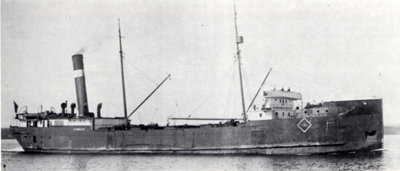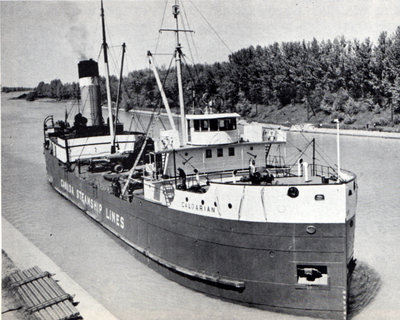Table of Contents
Over the years, we have presented in these pages the histories of a number of the canal-sized freighters that plied the Great Lakes and the St. Lawrence River before the advent of the St. Lawrence Seaway. We have chosen those canallers to be featured because they were significant in some manner, usually because they had long lives or because they were involved in interesting incidents. In the case of this issue's Ship of the Month, we have selected the vessel simply because she was one of the most handsome of the canallers, and because several readers wrote to us asking that we write up her story. That is good enough for us!
The steamer GLENELLAH (C.112205) was a 'tween-deck package freighter which was built in 1905 by the Caledon Shipbuilding and Engineering Company Ltd. at Dundee, Scotland, as its Hull 183. She was 250.0 feet in length, 43.2 feet in breadth, and 23.5 feet in depth, and her tonnage was 2272 Gross, 1454 Net. These dimensions made her just about as large a ship as could be handled in the locks of the old St. Lawrence and Welland Canals. She was powered by a triple expansion engine with cylinders of 19 1/2, 33 and 54 inches and a stroke of 36 inches. Steam was provided by two single-ended Scotch boilers, which were fired with coal. The machinery was built for the vessel by the shipyard.
GLENELLAH was constructed to the order of the Union Steamship Company Ltd., Hamilton, Ontario, which was one of the numerous concerns managed by the famous shipping entrepreneurs R. O. and A. B. Mackay. After her completion and acceptance by her owners, she sailed in ballast across the North Atlantic, and she arrived safely at Toronto, having made her first upbound transit of the old canals. Her first lake trip began on Wednesday, October 4th, 1905, when she sailed from Toronto, presumably with a cargo of package freight, bound for Fort William, Ontario. We do not know for sure, but we suspect that the ship then loaded a cargo of grain consigned to Montreal, as did many of the package freight canallers on their downbound trips.
During the years that she was owned by the Mackays, GLENELLAH's hull was painted black, while her cabins were white and her stack was red with a wide black smokeband. In 1908, the Mackays consolidated their lake shipping interests into the Inland Navigation Company Ltd. The control of this firm was acquired in 1910 by James Playfair, of Midland, Ontario, and his associates, and the name of the company was changed to Inland Lines Ltd. The colours of GLENELLAH were not altered during the course of these various corporate changes, and the steamer continued to operate in the usual canal trades, as also did her almost-exact sisterships DUNDEE and DUNELM.
These three canallers were amongst the most handsome ever built for lake service, although GLENELLAH was the only one of the three that would enjoy a long lake career. She had rather more freeboard than most canallers, and her hull had a bit of sheer, although not very much. (Many of the canallers had virtually no sheer at all.) She had a full raised forecastle, and a closed rail ran back for about three-quarters of its length. The bridge structure was set back off the forecastle, abaft the first hatch, and a closed steel rail ran back down the spar deck as far as the cabin to give it additional shelter from the seas. The texas cabin was a fairly large steel structure, with one window on each side and four across the front.
Above the texas was placed the rectangular wooden pilothouse, which sported three windows in its front. The centre window was a large one, and to each side of it was a smaller window, flanked in turn by a small porthole. Atop the pilothouse was an open navigation bridge, equipped with flying bridgewings. The tall, heavy, pole foremast was stepped one hatch abaft the bridge and it was fitted with two heavy cargo booms as well as a large square crows nest. The mainmast, which carried one cargo boom, was set just forward of the sixth and last hatch. Three cargo ports were set into each side of the steamer to provide additional access to the 'tween decks and lower holds.
GLENELLAH was given a large after cabin, the forward end of which formed the boilerhouse, and coal was loaded into the bunkers via a large hatch set in the forward end of the boat deck. Shelter for the after cabin was provided by a closed steel taffrail which ran down both sides of the deckhouse and around the fantail, above her finely cut counter stern. Out of the aft cabin rose a very tall and rather thin stack, which was raked so heavily that it matched the lines of the very tall spars.
GLENELLAH was involved in relatively few accidents over her many years of service. However, on Monday, August 2, 1909, whilst upbound from Montreal to Fort William, she struck the east breakwater at Port Colborne, causing considerable damage to her bows and displacing a portion of the breakwall. A failure of her steering gear was determined to have been the cause of the accident. Then, early in July of 1910, she ran aground at Presqu'ile, but she was released on July 7th with no reported damage.
Inland Lines Ltd. operated GLENELLAH for only a very few years, for in 1913, the Playfair interests were instrumental in the formation of Canada Steamship Lines Ltd., Montreal, which was to be the largest Canadian fleet ever to sail the Great Lakes. After the merger which created C.S.L., GLENELLAH retained her old name but she took on new colours. Her hull became red, and the letters 'C.S.L.' were carried in white inside a white-outlined diamond on the bow. Her deckhouses at first were grey with white trim, but the cabins later were painted all white. Her stack took on the now-familiar colours of red with a white band and black top, this change occurring about 1920.
During World War One, many of the canallers were taken up for war service on the east coast and North Atlantic. GLENELLAH and her two sisters were no exception, and GLENELLAH served on salt water from 1915 until the cessation of hostilities in 1918. Unfortunately, she was the only one of the three sisterships to survive the war and return to peacetime duties on the lakes.
During the mid-1920s, GLENELLAH was given a small, rounded, wooden pilothouse which was built on the navigation bridge, and this served to give the officers on watch some protection from the elements. The new house protruded slightly through the weathercloth which was stretched across both bridge wings, and in the 1930s a sunvisor was added to this cabin. At the outset of the 1927 season, the ship was renamed (b) CALGARIAN. The new name was not only part of a concentrated effort by C.S.L. to remove the old Playfair names beginning with the "Glen" prefix, but also reflected the company's dedication to the people and business of Canada, honouring the residents of the city of Calgary, Alberta. The ship was the second canaller to bear the name CALGARIAN, the first having been lost during the Great War.

The date is 1922 and GLENELLAH is downbound at Little Rapids Cut in this Young photo.
It should also be noted that, at the same time the ship was renamed, the old C.S.L. diamond was removed from CALGARIAN's bows. Instead, in the fashion still carried on even today, the Canada Steamship Lines name was painted in large white letters down the ship's sides. Concurrently, the steamer's forecastle was painted white.
In the years following the Second World War (CALGARIAN remained on the lakes during that conflict), the ship was given a new and much larger steel pilothouse. As well, she was reboilered in April of 1950, receiving one large single-ended Scotch boiler which had been built in 1940 and which she inherited from a scrapped Royal Canadian Navy warship. At the time of her reboilering, CALGARIAN was given a new funnel, which was tall but much heavier than the original, and which did not do much for her looks in that it imparted a rather ponderous look to her after end. As well, during 1957, the steamer's old foremast was removed and in its place a very short pipe mast was stepped behind the pilothouse. All of these changes combined to update the appearance of CALGARIAN, but they detracted rather considerably from her previously graceful lines.

The camera of J. H. Bascom caught CALGARIAN upbound below W. S. C. Lock One in May of 1955.
As might have been expected, CALGARIAN fell victim to the opening of the St. Lawrence Seaway, which rendered obsolete most of the canallers. She continued to operate through the 1959 season and then was retired. As far as we know, she did not run in 1960, and was sold that year to the Steel Company of Canada Ltd. She was towed to Hamilton and was broken up there during the 1961 season. Her set-back pilothouse had made her one of the more unusual C.S.L. package freight canallers during her latter years, and her appearance recalled the lines of some of the early upper lake package freighters which had been operated by the U.S. railroads. She was a good looking boat in her day but she could not compete with the newer vessels that were introduced into the C.S.L. fleet in the immediate pre- and post-Seaway years.
Previous Next
Return to Home Port or Toronto Marine Historical Society's Scanner
Reproduced for the Web with the permission of the Toronto Marine Historical Society.